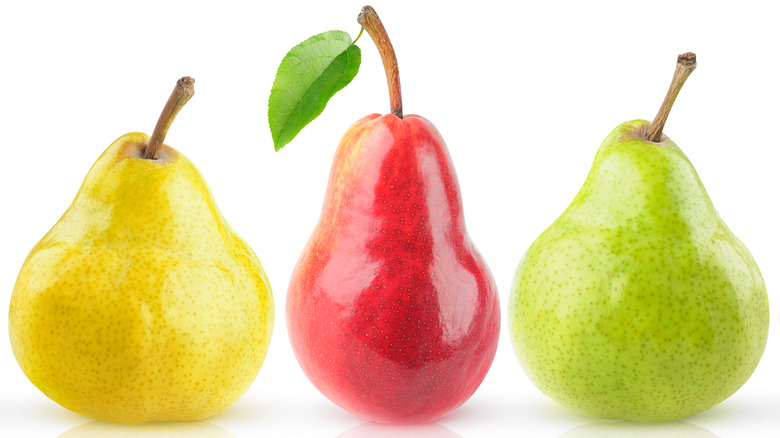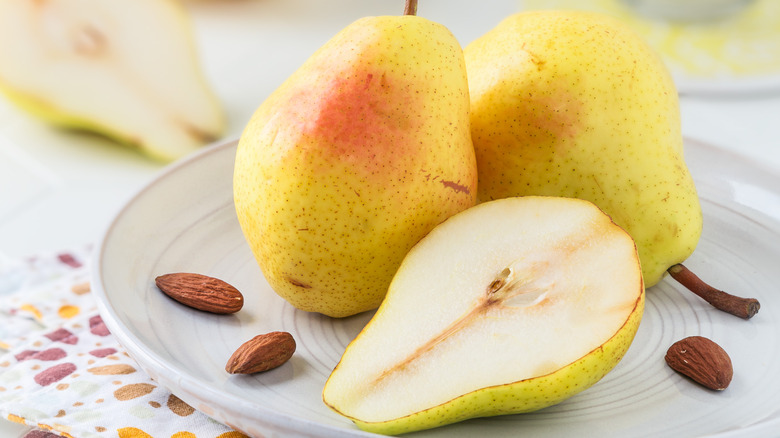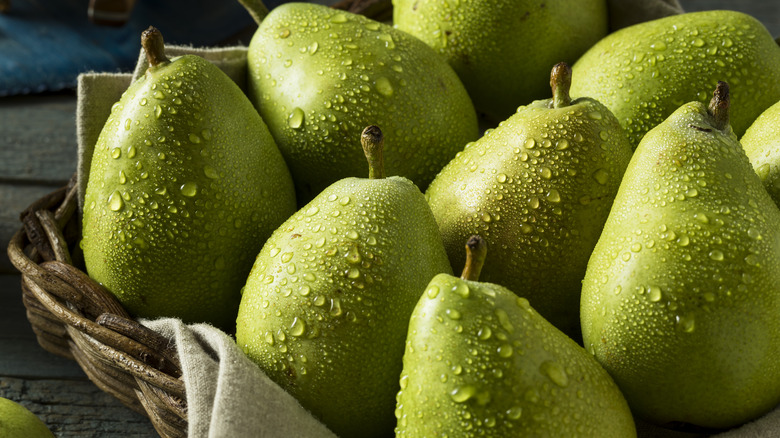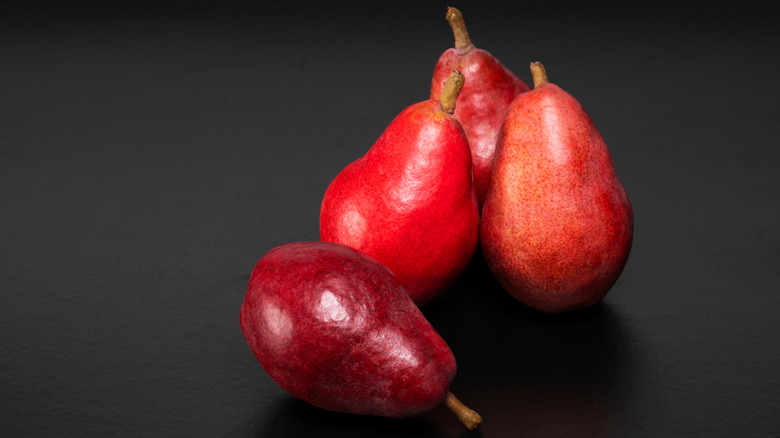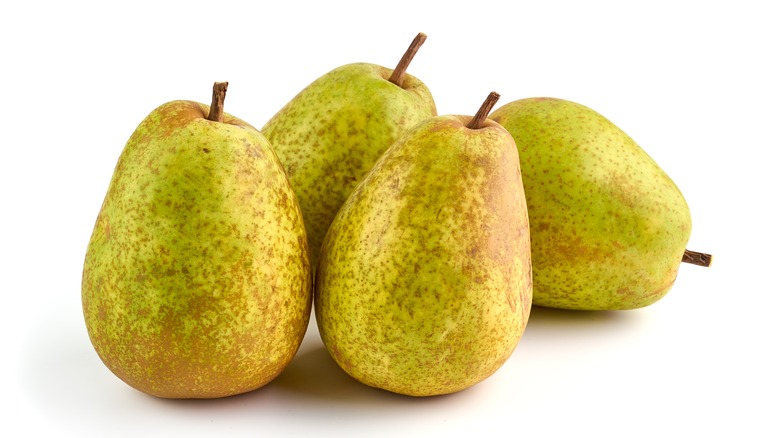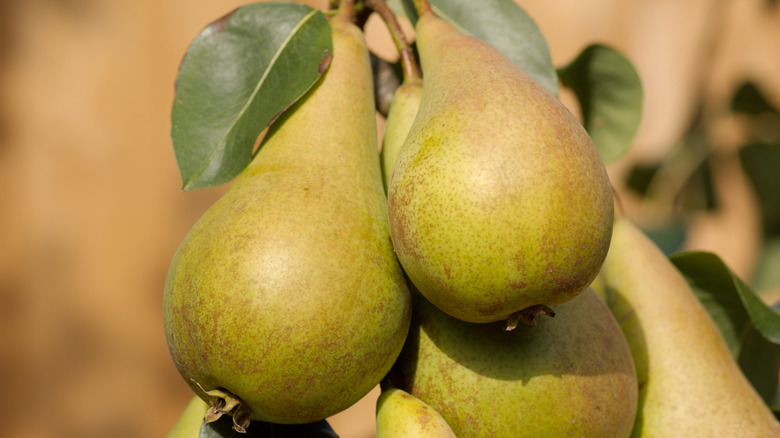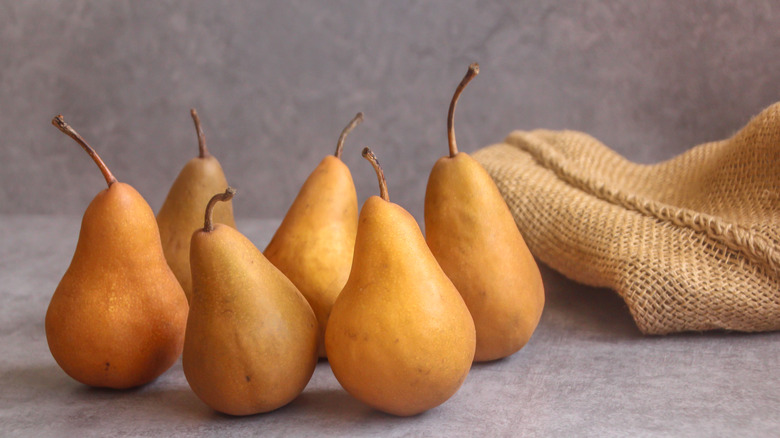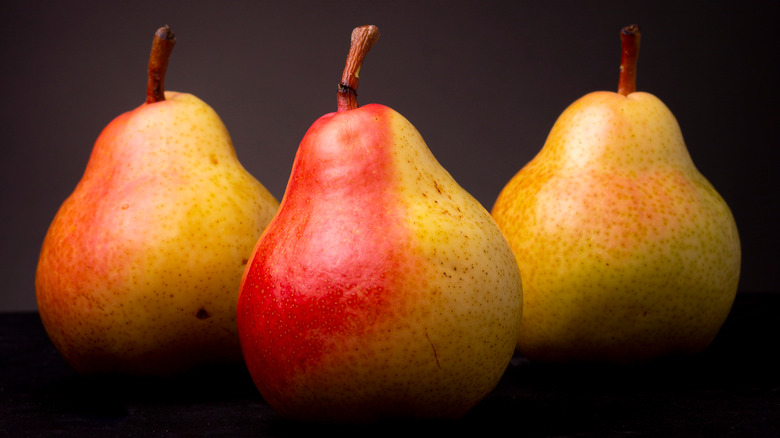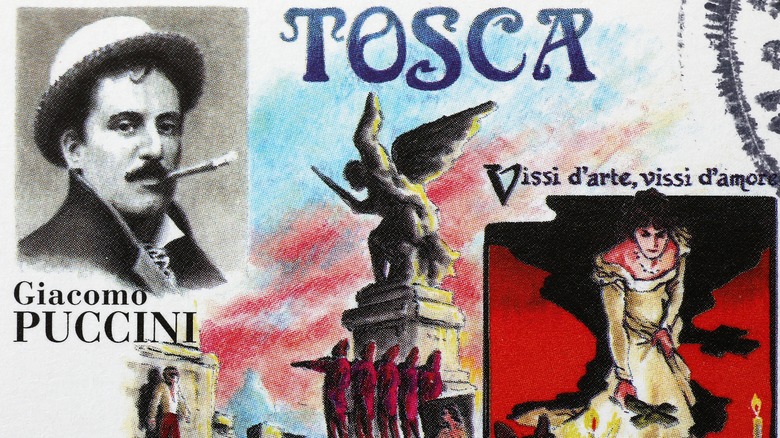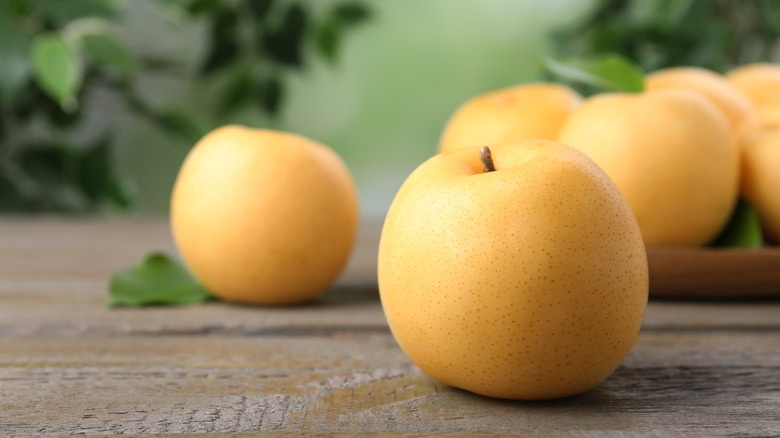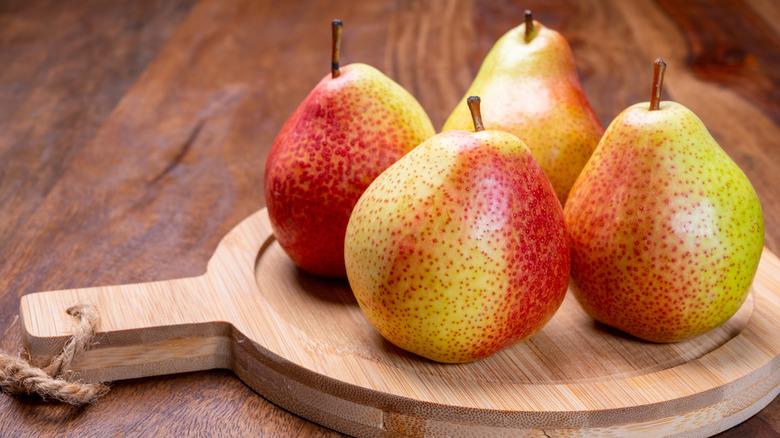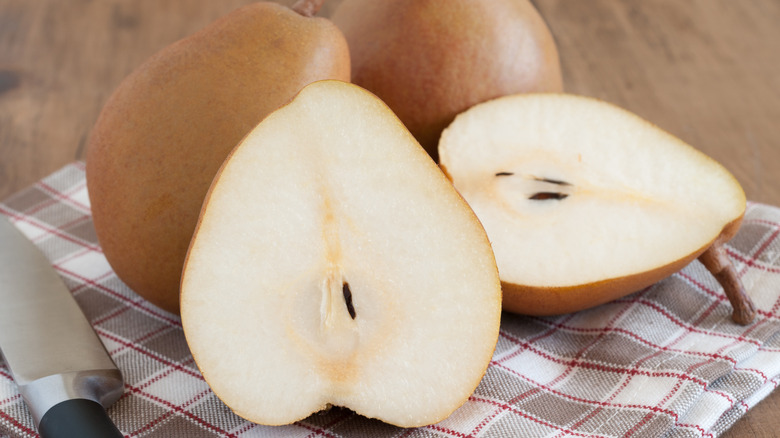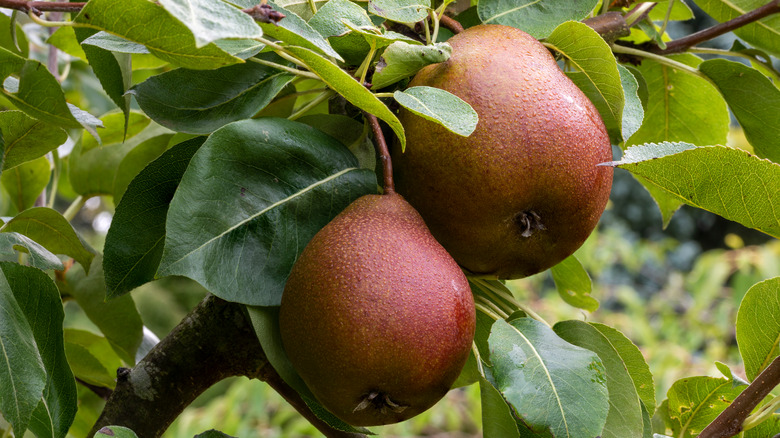12 Types Of Pears And What Makes Them Unique
Most people probably think they know pears. After all, if pears could win Olympic medals, they would tie with apples for the silver in the category of most consumed fruit in the United States (via World Apple and Pear Association). However, just because something has the word "pear" in its name doesn't make it a pear.
For example, the mildly sweet cactus pear isn't a pear at all, according to the Farmer's Almanac. It's only called a pear because it has a similar appearance to one. The vegetable pear (aka the mirliton or chayote) is actually a type of gourd that tastes similar to a cucumber. And then there's the alligator pear, which, as Culinary Lore explains, is another name for the avocado. Why? Well, if you're in Mexico, then an avocado might be called an "aguacate," and some believe this word was at some point in history mispronounced, which led to avocados being called alligator pears. In addition, the skin of an avocado is reminiscent of an alligator's, and it's shaped a bit like a pear.
Of course, just because some foods are incorrectly called pears doesn't mean there aren't many types of actual pears in the world. What's more, they come in different colors, sizes, shapes, and textures. And while some might be ideal for cooking or baking, others are best when eaten raw or cold. So, it's important to know the right variety of pear to pick up for a recipe.
Bartlett or Williams' Bon Chrétien
While most people in the United States are familiar with the Bartlett pear, it actually goes by a completely different name — Williams' Bon Chrétien — elsewhere in the world (via Britannica).
According to the Arbor Day Foundation, a man named John Stair first found this pear growing wild in England in 1770. The reason why the pear is called a Williams' Bon Chrétien or simply a Williams pear is because Stair sold cuttings from the pear tree to a man named Williams. Since Williams was a nurseryman (a person who works and cultivates plants for sale), he used the cuttings to create a whole new product. Eventually, these pears made their way to America to a man named Enoch Bartlett, who grew them unaware of their European origins.
Yes, the Bartlett or Williams' Bon Chrétien pear has had quite a journey, but given this fruit's positive qualities, it's no surprise that it has been so popular. Not only are these pears one of the larger varieties, but they are also versatile as a culinary ingredient because of their juiciness and smooth texture. And one more thing to keep in mind: There are both green and red varieties of this pear (via USA Pears).
Green Anjou
Anjou pears have some things in common with their Bartlett cousins. There are red and green varieties of Anjou, and as USA Pears notes, they also go by more than one name: d'anjou. This is because the name Anjou is a region located in France, and so these egg-shaped pears were called Beurré d' Anjou as they made their way to different parts of the world.
Now, of course, anyone who regularly enjoys fruit will tell you that timing is everything. In other words, if you're going to sink your teeth into a nice piece of fruit, you want to make sure it's neither underripe nor overripe. Otherwise, both the flavor and the texture can be affected. However, unlike other fruits that change color when they ripen, green Anjou pears change very little in appearance as they ripen, per USA Pears. Fortunately, there's a simple trick to avoid eating a green Anjou pear too soon or not soon enough. Simply press the top of the pear (the part with the stem), and when it gives a little, you have a nice and ripe green Anjou.
Since Anjou pears are both juicy and dense, they are good raw and as an ingredient in a number of recipes. For instance, Anjou pears can be poached or baked and are particularly delicious when grilled or roasted.
Starkrimson
No, this next pear isn't named after Tony Stark from "Iron Man" (although, like his famous mechanical suit, the Starkrimson is red, according to the Washington Fruit Growers). In fact, the reason why we have Starkrimson pears today has something in common with another group of Marvel superheroes, the mutants of the X-Men.
Yes, that's right, Starkrimson pears got their start because of a mutation, per Gardening Know How. A tree in Missouri that usually only had green pears began growing red ones on one of its branches. Naturally, once these pears existed, it was possible to cultivate more, and the Starkrimson variety of pear was born. As for the name, the Stark part came from the nursery Stark Brothers, which is still in existence today. According to the company's website, its founder, James Hart Stark, began with apple trees, and since then, the company has expanded to include other types of fruit trees, nut trees, and other varieties of plants.
Besides the striking color of Starkrimson pears, they also stand out because of their juice content. As Washington Fruit Growers notes, they contain a large amount of juice, so they're especially good for snacking raw. In addition, their red color can also enhance the presentation of a dish.
Comice
This next pear might be one of Santa's favorites. As Gardening Know How explains, although it's called the Comice pear, it's also informally known as the "Christmas Pear" because it's a favorite choice for gift boxes in December. And it's no wonder since, as Hale Groves points out, this is one of the larger varieties of pears, so it works well as a present (or, more specifically, as part of a present). In fact, it's notably rounder than other pears, although it still has a neck (albeit a shorter one than some other varieties).
Besides the size, Comice pears are especially sweet and juicy. As for its texture, both Gardening Know How and Hale Groves describe it as creamy. In addition, its skin, which tends to be green with some red (but not always), is softer than other pears. And there's no need to worry about the hard core since the only parts of a Comice pear that can't be eaten are the seeds and stem.
While Comice pears check quite a few boxes when it comes to an ideal snacking pear, they do have their limitations in the kitchen. Unfortunately, this creamy pear doesn't have the hardiness for cooking. Also, throwing this pear in the fridge will noticeably decrease its sweet, juicy nature.
Concorde
You might have heard the word "Concorde" (albeit slightly different spelling) when it comes to grapes, but don't overlook the sweet Concorde pear. According to USA Pears, this variety of pear has a similar flavor as Comice pears — and for a good reason. Concorde pears are actually a cross between Comice and another pear.
Yes, just like how crossbreeding two different breeds of dog creates an entirely different animal, it's possible to merge the qualities of various pears. In this case, the Concorde comes from the Comice and the Conference pear, the latter being why it has a longer neck than the Comice. It is also crispier and denser than Comice pears, so it's a good choice. In fact, don't worry about turning up the heat (within reason) because these pears can maintain their shape better than some other pear varieties when a recipe calls for cooking at a high temperature.
Besides its neck and density, there are some other telltale signs a pear is a Concorde pear. If the pear has a stem on it, check if it's long and curved, which are very common for Concordes. Also, the color of Concorde pears tends to be yellow-green with some golden russet. And one more note: While some fruits turn brown very quickly once cut, Concorde pears turn brown more slowly, making for an excellent presentation.
Bosc
When it comes to pears, there's one term you should know — russeting. As the National Center for Biotechnology Information explains, russeting happens when the surface of the fruit develops microscopic cracks. But don't let that concern you. For example, Bosc pears can have so much russeting on their skin that you might think for a moment that the pear has been dipped in cinnamon (via USA Pears). However, that doesn't impact their quality.
Yes, if you were to take a bite out of a Bosc pear, the flavor would be sweet and even reminiscent of honey. It would probably also be firmer and denser than, for example, a Comice pear, making it a good choice for various cooking projects. For example, if you want to make poached pears, Bosc pears are an excellent choice. They're also great broiled or baked. And while some pears need to ripen to a certain point for their flavor to shine, Bosc pears are sweet and juicy even before they are fully softened.
While Bosc pears have some noteworthy qualities in terms of flavor and texture, they're also unique because of their history. There's a bit of controversy behind who can claim credit for the Bosc pear, per USA Pears. On the one hand, some believe a Mr. M. Bosc grew the first Bosc pear in Belgium. Others, however, think the pear's origin was a seedling tree in France.
Seckel
The Seckel pear has a bit of a legendary history. According to USA Pears, this member of the pear family might have started out as a wild pear that first grew in Philadelphia. However, there is a chance that immigrants coming from Germany to the United States might have been the true source of the Seckel.
Whatever way they came to grow in the U.S., Seckels are one of the smallest pear varieties. In fact, you'd be forgiven if you mistook one for a young pear that's not fully ripened. After all, Seckels not only lack the long necks of some other pears, but they're also round and chubby. As for its coloring, Seckels often combine maroon and olive green. But beyond their appearance, the thing about Seckels that really makes them stand out is their lovely sweet taste. As Gardening Know How points out, Seckels are sometimes referred to as Seckel sugar pears and are a favorite healthy option for snacks, cooking, and, of course, desserts.
Although you can store Seckel pears in the refrigerator anywhere from two to seven days, there are some precautions when it comes to this fruit (via Oregon Live). For one, ripening it at room temperature and then returning it to the fridge increases the odds of the pear becoming mushy and unappetizing. Also, moisture that forms on fruit in a fridge can lead to decay when the fruit is removed from the fridge and left out.
Tosca
It's not uncommon for a pear to be named after a person (or, in some cases, more than one person). However, according to Gardening Know How, Tosca pears, which started in Italy, might have gotten their name from an opera. Written by Giacomo Puccini, the opera "Tosca" is set during the Napoleonic wars and features a story that blends romance and political intrigue (via Britannica).
Even if you're not a fan of opera, the Tosca pear has a great deal to offer. Like the Concorde pear, Tosca combines two other pear varieties: the Bartlett and the Coscia. So, if you're at the supermarket and cannot find Bartletts for a recipe, you might want to consider substituting Toscas. Yes, these bell-shaped pears hold up fine when cooked or are perfectly good raw. And although they don't change color as they ripen, they become fragrant when ready to eat. Plus, like many pears, pressing the top of a Tosca can help you determine if they're fully ripe.
Although Toscas share similarities with some pears, one of their most unique qualities is that they ripen quite early compared to other pear family members. As Gardening Know How explains, you might see Toscas at a farmer's market as early as late summer, while other pears might not make their first appearance at fruit stands until the fall.
Bae Pears
Let's clear up one potentially confusing thing about this next pear. As wholesale produce company Louisiana Fresh points out, Bae pears go by multiple names, including apple pears, bapples, and even Nashi apples. But despite the fact Bae pears are round and crunchy like apples, they are not a cross between a pear and an apple.
Okay, now that we've clarified that, let's talk about the juicy details. Bae pears are rounder than most pears and come in different colors. For example, Bae pears can be brown but also might be yellow or green. However, one big difference is that compared to other pears, which are tender and buttery, Bae pears are crispy and grainy. And their flavor can actually be more tart than other pears. Plus, they can last several weeks stored in a dry, cold environment.
Although Bae pears make a nice snack as is, they can also be a great ingredient for a variety of recipes (via My Korean Kitchen). One of the most common ways is Korean-style meat marinades, such as bulgogi.
Forelle
If you used Google to translate the word "Forelle" from German to English, it would be "trout." Yes, technically, the name of this next variety of pears is trout pears. But don't let that prevent you from trying them. As USA Pears explains, Forelle pears are named after the colors of a Rainbow trout, not their taste.
These sweet pears have red freckles (or more formally called lenticles), reminiscent of a Rainbow trout's skin. And speaking of a Forelle pear's skin, one reason this variety of pear is unique is because it noticeably changes color as it ripens, turning from green to yellow. However, Forelle pears maintain their "freckles" throughout the ripening process.
Although Forelle pears are one of the firmest varieties of pears, USA Pears notes a big disadvantage when it comes to cooking with them — their size. In other words, if you're making a Pear-Ginger pie, you're going to need more Forelle pears than Bartlett or Anjou pears to fill your pie's crust. Are they the smallest pear? No, but because of their diminutive size, they're actually an excellent ingredient for salads.
Taylor's Gold
If you live in the United States, there's a chance you've never heard of Taylor's Gold pears (via Gardening Know How). According to the International Society for Horticultural Science, it's difficult to grow these pears with a russet in certain areas of the U.S., making marketability difficult.
According to Gardening Know How, while golden-brown Taylor's Gold pears aren't as widely available as other pear varieties, they can be marvelous additions to baking recipes and jams. This is because Taylor's Golds are very tender like Comice pears. In fact, some believe that Taylor's Gold pears might either be related to Comice pears or is a cross between them and Bosc pears.
Although Taylor's Gold pears have their upsides in the kitchen, they also have one key limitation. As Gardening Know How explains, this variety of pear is so soft that it's not a good choice for poaching. However, it does make a very nice healthy snack when eaten raw.
Black Worcester pear
If you ever visit Worcester, England (or happen to live there), take a good look at the city's coat of arms. As the Slow Food Foundation for Biodiversity points out, you'll see it features Black Worcester pears. And if you're wondering why it's because Queen Elizabeth, who saw the pears when she visited Worcester in 1575, had the coat of arms updated with the fruit.
Although Black Worcester pears have a place of prominence on Worcester's coat of arms, don't expect to see this variety of pears at the supermarket. According to the Slow Food Foundation for Biodiversity, these mahogany pears with russets are only grown in private orchards. What's more, Black Worcester pears aren't ready to eat soon after harvesting. As a matter of fact, if they're harvested in the fall, they need to be stored for months before their flavor is just right. Yes, you read that right — months. That means if you were to grow these pears, you couldn't enjoy one until at least January, and even then, you might want to wait until the spring.
While Black Worcester pears are better for cooking than eating raw, they need to be cooked for at least an hour because of their firmness. Additionally, one of the most famous dishes featuring these pears is Warden pies, which were referenced in the Shakespearian play "The Winter's Tale."
